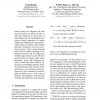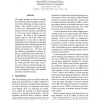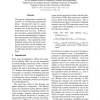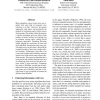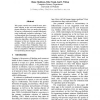118
click to vote
EMNLP
2009
14 years 10 months ago
2009
Polarity lexicons have been a valuable resource for sentiment analysis and opinion mining. There are a number of such lexical resources available, but it is often suboptimal to us...
89
Voted
EMNLP
2009
14 years 10 months ago
2009
We propose a novel unsupervised approach for distinguishing literal and non-literal use of idiomatic expressions. Our model combines an unsupervised and a supervised classifier. T...
118
Voted
EMNLP
2009
14 years 10 months ago
2009
Current system combination methods usually use confusion networks to find consensus translations among different systems. Requiring one-to-one mappings between the words in candid...
101
click to vote
EMNLP
2009
14 years 10 months ago
2009
Jointly parsing two languages has been shown to improve accuracies on either or both sides. However, its search space is much bigger than the monolingual case, forcing existing ap...
92
Voted
EMNLP
2009
14 years 10 months ago
2009
This paper addresses the issue of extracting contexts and answers of questions from post discussion of online forums. We propose a novel and unified model by customizing the struc...
129
click to vote
EMNLP
2009
14 years 10 months ago
2009
Many named entities contain other named entities inside them. Despite this fact, the field of named entity recognition has almost entirely ignored nested named entity recognition,...
138
Voted
EMNLP
2009
14 years 10 months ago
2009
This paper presents an effective method for generating natural language sentences from their underlying meaning representations. The method is built on top of a hybrid tree repres...
106
Voted
EMNLP
2009
14 years 10 months ago
2009
The sense of a preposition is related to the semantics of its dominating prepositional phrase. Knowing the sense of a preposition could help to correctly classify the semantic rol...
112
click to vote
EMNLP
2009
14 years 10 months ago
2009
Many algorithms extract terms from text together with some kind of taxonomic classification (is-a) link. However, the general approaches used today, and specifically the methods o...
109
Voted
EMNLP
2009
14 years 10 months ago
2009
This paper connects two research areas: automatic tagging on the web and statistical keyphrase extraction. First, we analyze the quality of tags in a collaboratively created folks...

